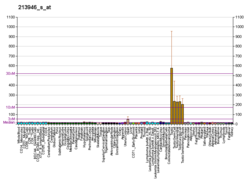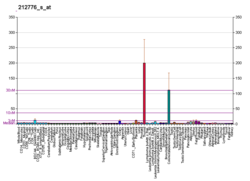| OBSL1 |
|---|
 |
| Available structures |
|---|
| PDB | Ortholog search: PDBe RCSB |
|---|
| List of PDB id codes |
|---|
2CPC, 2E6P, 2E6Q, 2LU7, 2LVC, 2WP3, 2WWK, 2WWM, 3KNB |
|
|
| Identifiers |
|---|
| Aliases | OBSL1, obscurin like 1, obscurin like cytoskeletal adaptor 1 |
|---|
| External IDs | OMIM: 610991; MGI: 2138628; HomoloGene: 28013; GeneCards: OBSL1; OMA:OBSL1 - orthologs |
|---|
| Gene location (Human) |
|---|
 | | Chr. | Chromosome 2 (human)[1] |
|---|
| | Band | 2q35 | Start | 219,550,728 bp[1] |
|---|
| End | 219,571,859 bp[1] |
|---|
|
| Gene location (Mouse) |
|---|
 | | Chr. | Chromosome 1 (mouse)[2] |
|---|
| | Band | 1|1 C4 | Start | 75,455,954 bp[2] |
|---|
| End | 75,483,096 bp[2] |
|---|
|
| RNA expression pattern |
|---|
| Bgee | | Human | Mouse (ortholog) |
|---|
| Top expressed in | - right testis
- left testis
- left ovary
- right ovary
- right lobe of thyroid gland
- left lobe of thyroid gland
- right adrenal cortex
- right uterine tube
- apex of heart
- right hemisphere of cerebellum
|
| | Top expressed in | - yolk sac
- internal carotid artery
- external carotid artery
- fossa
- muscle of thigh
- condyle
- vas deferens
- renal corpuscle
- genital tubercle
- medullary collecting duct
|
| | More reference expression data |
|
|---|
| BioGPS | 

 | | More reference expression data |
|
|---|
|
| Gene ontology |
|---|
| Molecular function | - cytoskeletal anchor activity
- protein binding
- structural constituent of muscle
- actin filament binding
- muscle alpha-actinin binding
- structural molecule activity conferring elasticity
| | Cellular component | - Z discdkac
- 3M complex
- intercalated disc
- M band
- centrosome
- microtubule organizing center
- cytoskeleton
- cytoplasm
- Golgi apparatus
- perinuclear region of cytoplasm
- muscle myosin complex
- cytosol
- striated muscle thin filament
- sarcomere
| | Biological process | - protein localization to Golgi apparatus
- cardiac myofibril assembly
- microtubule cytoskeleton organization
- cytoskeleton organization
- regulation of mitotic nuclear division
- positive regulation of dendrite morphogenesis
- Golgi organization
- striated muscle contraction
- actin filament organization
- sarcomere organization
- striated muscle myosin thick filament assembly
- post-translational protein modification
- muscle contraction
- skeletal muscle thin filament assembly
- skeletal muscle myosin thick filament assembly
- cardiac muscle tissue morphogenesis
| | Sources:Amigo / QuickGO |
|
| Orthologs |
|---|
| Species | Human | Mouse |
|---|
| Entrez | | |
|---|
| Ensembl | | |
|---|
| UniProt | | |
|---|
| RefSeq (mRNA) | |
|---|
NM_001173408
NM_001173431
NM_015311 |
| |
|---|
| RefSeq (protein) | |
|---|
NP_001166879
NP_001166902
NP_056126 |
| |
|---|
NP_001297608
NP_849215
NP_001390042
NP_001390043 |
|
|---|
| Location (UCSC) | Chr 2: 219.55 – 219.57 Mb | Chr 1: 75.46 – 75.48 Mb |
|---|
| PubMed search | [3] | [4] |
|---|
|
| Wikidata |
| View/Edit Human | View/Edit Mouse |
|

 2cpc: Solution structure of RSGI RUH-030, an Ig like domain from human cDNA
2cpc: Solution structure of RSGI RUH-030, an Ig like domain from human cDNA





















